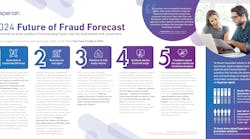From the rapid adoption of digital experiences to the generative AI boom, technology has made incredible advances over the last few years. While the innovation we’ve witnessed brings a plethora of opportunity for businesses and consumers, it also comes with increased challenges and risks. Fraudsters are keeping a close eye on ever-evolving technology and finding the best ways to leverage it in new and sophisticated ways to make committing fraud easier and more difficult to detect.
Businesses are feeling the pressure to protect themselves and their customers from fraud. An Experian report found that over 50% of businesses report a high level of concern about fraud risk while nearly 70% of businesses reported that fraud losses have increased in recent years. It’s crucial that businesses are aware of emerging fraud trends so they can stay one step ahead of these bad actors. Experian recently released five fraud predictions for 2024 to help businesses understand emerging fraud threats and how they can mitigate risk to protect themselves and the customers they serve.
Generative AI accelerates DIY fraud
Generative artificial intelligence has exploded in popularity in recent years. Its sudden growth and accessibility have brought many benefits, but opportunistic fraudsters are also leveraging it to commit crime. Experian predicts fraudsters will use generative AI to accelerate “do-it-yourself” fraud with a wide range of deepfake content, such as emails, voice and video as well as code creation to set up scam websites and perpetuate online attacks.
Generative AI makes developing fraud schemes easier, more accurate and more realistic, making it difficult to know what is real and what isn’t. These bad actors will also use generative AI to socially engineer “proof of life” schemes, using stolen identities to create fake identities on social media. They can then interact online with these new profiles as if they are real consumers, making it difficult to investigate fraud because the profile seems legitimate.
Branches are cool again
While consumers have largely turned to digital lending and banking experiences in recent years, many consumers are heading in-person to bank branches for security and peace-of-mind. Being able to accurately verify identities at the branch and leveraging the right tools to do so will be important. This is especially true as 85% of consumers report physical biometrics as the most trusted and secure authentication method they’ve recently encountered.
However, the measure is only currently used by 32% of businesses to detect and protect against fraud, according to the Experian report. Experian predicts lenders will implement more digital identity verification steps, like physical biometrics, at branches for in-person account openings to protect legitimate customers and mitigate losses.
Retailers hit with empty returns
With the popularity of online shopping, fraudsters will ramp up their efforts to defraud retailers. Bad actors will use a “bait-and-switch” method involving returning an item they purchased via mail but when the business receives the box, it’s empty. The customer will claim that they returned the product and it must have been lost during the shipping process, but in reality they kept it. Experian forecasts that more criminals will use this method to keep merchandise in 2024, leaving businesses with lost goods and revenue.
Synthetic identity fraud will surge
During the pandemic, many fraudsters created synthetic identities but then quickly found easier methods to steal funds through various aid programs. Synthetic identities are fake identities made up of both real and false information. Fraudsters use these identities to apply for loans and credit cards and slowly build out credit history to seem legitimate. They eventually “bust out” or max out their available credit and disappear. Though they may have been dormant, these synthetic identities now have a few years of history.
Experian predicts this will make it easier to elude detection — leading to fraudsters using those dormant accounts to “bust out” and steal funds over the next year. Businesses will need to collaborate more closely than ever with their fraud-prevention partners to review their current portfolios for synthetic identity accounts.
Fraudsters expand into cause-related and investment deception
Criminals are not afraid to prey on people’s generosity and are leaning on new methods of fraud that strike an emotional chord with their victims. Fraudsters are leveraging fake GoFundMe campaigns, social media giveaways, investment opportunities and text fraud for cause-related asks or too-good-to-be-real offers to gain access to consumers’ personal information. Experian predicts that there will be an increase in this type of fraud.
Businesses face the challenge of staying up to date on trends and technological advances while also protecting themselves and their customers from the risks such innovation brings. Businesses can stay ahead of emerging risks by staying proactive and implementing the right fraud solutions.
To do so, businesses should:
- Work with a trusted partner: The right partner can help businesses analyze their current fraud tools and their portfolio to identify the right identity verification solution and technology needed to detect fraud and reduce future losses.
- Implement a data-driven multilayered approach to fraud: To properly address fraud, businesses need intelligent data and analytics to turn insights into action. By implementing a multilayered fraud strategy, companies can identify and mitigate multiple types of fraud to protect themselves and their customers.
- Leverage machine learning to streamline fraud management: Machine learning can play an important role in a business’s fraud prevention strategy. Experian’s report found that 90% of businesses that already leverage machine learning reported a high level of confidence in their effectiveness at fraud detection and prevention.
Machine learning can help detect and prevent fraud threats in real time and analyze a large quantity of transactions and data sets automatically. This can identify fraud quickly and minimize customer friction. In addition, machine learning can constantly learn from previous transactions and new fraud patterns so it becomes smarter and faster over time.
Fraud is continually evolving, and new types are being developed and utilized by criminals. As bad actors continue to leverage technology to become faster and more sophisticated, businesses will need to ensure they have the right fraud solutions in place to protect themselves and their customers now and in the future.
About the Author
Kathleen Peters, Chief Innovation Officer, leads innovation and business strategy for Experian’s Decision Analytics in North America.





